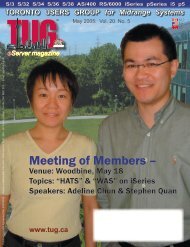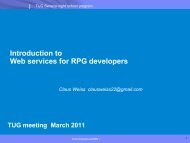Complete Magazine - PDF (5589K) - Toronto Users Group for Power ...
Complete Magazine - PDF (5589K) - Toronto Users Group for Power ...
Complete Magazine - PDF (5589K) - Toronto Users Group for Power ...
Create successful ePaper yourself
Turn your PDF publications into a flip-book with our unique Google optimized e-Paper software.
Clouds Ahead <strong>for</strong> SOA on IBM i?<br />
By Glenn Johnson,<br />
Senior Vice President,<br />
Magic Software Enterprises Americas<br />
Do you remember the two-page<br />
spread advertisements in Forbes,<br />
Fortune, Business Week, and<br />
Optimize featuring TUG<br />
Member Paul Leone, the CIO of adidas<br />
Canada? Proudly, my connection with<br />
TUG is how my business relationship with<br />
Paul Leone began nearly a decade ago. The<br />
advertisements that Paul was featured in<br />
posed the question: “Why i?” Of course<br />
readers here all know the reasons why.<br />
IBM System i users have a right to be<br />
proud. Years ago, we made a wise choice<br />
to invest in a hardware plat<strong>for</strong>m (the<br />
AS/400), an operating system (OS/400), a<br />
programming language (RPG), and robust<br />
business applications that have proved<br />
over the years to be easily maintainable,<br />
incredibly reliable and extremely easy to use<br />
and understand, delivering a high return on<br />
investment.<br />
But today, everyone’s talking about<br />
“modernization,” which often translates<br />
into messages that OS/400 users must<br />
move off the IBM i plat<strong>for</strong>m, abandon the<br />
“legacy” applications that still deliver high<br />
value to the organization, or at the very<br />
least, adopt much more complex software<br />
components and complex languages such<br />
as Java. The simplicity, reliability and ease<br />
of use upon which IBM i users have relied<br />
<strong>for</strong> decades are suddenly in jeopardy. For<br />
modernization to make any sense, however,<br />
it cannot involve moving away from IBM i<br />
or increasing complexity.<br />
24<br />
Meeting New Business Demands With Existing IBM System i Applications:<br />
A Pragmatic Approach<br />
System i users have a lot invested in their OS/400 applications, but they know they<br />
need to modernize these applications and to meet new business demands and to<br />
integrate with other applications across the enterprise. This article will discuss a<br />
pragmatic approach <strong>for</strong> accomplishing this, without the need to implement complex<br />
technologies or programming languages, keeping the System i as the plat<strong>for</strong>m of<br />
choice <strong>for</strong> legacy and new business applications.<br />
Will it be possible <strong>for</strong> IBM i users to<br />
retain the benefits of the environment<br />
that has delivered so much value, while<br />
modernizing those applications so that<br />
they can be integrated into today’s wider<br />
IT community? Is there a way to take<br />
advantage of and protect the investment<br />
that still has great value to the organization<br />
while enhancing those applications to meet<br />
new business demands <strong>for</strong> extensibility,<br />
flexibility, agility, return on investment<br />
and communication with customers and<br />
business partners?<br />
Until relatively recently, most IT<br />
applications operated as “islands” of<br />
computing capability, communicating with<br />
each other via the transfer of files and reports.<br />
The usefulness of that model, however,<br />
has long since passed. It is certainly true<br />
that batch processing and near-real-time<br />
updates still provide a reliable and viable<br />
model <strong>for</strong> some applications. However,<br />
today, thanks in large part to the Internet,<br />
many businesses need to provide data in<br />
real time (on demand) to users, remote<br />
locations, customers and other points in<br />
the supply and service chain. The days of<br />
stand-alone islands of computing are fast<br />
disappearing.<br />
If a company is going to survive, let alone<br />
thrive, establishing a strong competitive<br />
edge in a global economy, even when it is<br />
servicing tight geographies and/or niche<br />
vertical markets, it will have to become<br />
part of the larger IT community, extending<br />
its business processes across both internal<br />
and external channels and across the Web.<br />
Following are some of the most common<br />
types of integration needs:<br />
• Linking product in<strong>for</strong>mation,<br />
inventory adjustments, order<br />
processing, credit approvals, and<br />
customer discount in<strong>for</strong>mation to an<br />
e-commerce website.<br />
• Enhancing customer service<br />
operations and help desks by<br />
connecting them directly to<br />
in<strong>for</strong>mation about customers, past<br />
calls, problem resolutions, order<br />
tracking, and more.<br />
• Synchronizing data between various<br />
remote offices.<br />
• Consolidating financial results of<br />
different business units.<br />
• Automating order processing and<br />
eliminating the need to create and<br />
mail or fax hard copies of purchase<br />
orders or invoices.<br />
• Meeting the requirements of other<br />
companies in the supply chain to<br />
automatically exchange documents in<br />
standardized electronic <strong>for</strong>m, directly<br />
from one application to another.<br />
• Enabling the sharing of data and logic<br />
between multiple applications that<br />
use that in<strong>for</strong>mation across diverse<br />
databases, applications, operating<br />
systems, and geographies.<br />
To meet any of these goals, System i<br />
applications will have to move off of the<br />
island and into the mainstream. This can be<br />
done—in a way that will let plat<strong>for</strong>m lovers<br />
maintain the simplicity, continue to enjoy<br />
the reliability, and protect and extend their<br />
investment in their proven applications.<br />
TORONTO USERS GROUP <strong>for</strong> <strong>Power</strong> Systems – January 2010





